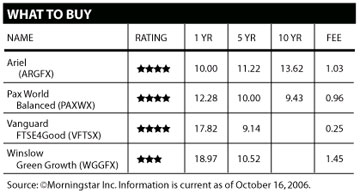Does green investing pay as well as conventional investing?
Does green investing pay as well as conventional investing?
My Money Is Greener Than Your Money
by Carol Vinzant
OnEarth Magazine
December 17, 2006
Socially responsible investing is now a major Wall Street trend. But the real question is this: Can you make as much dough when you’re being virtuous?
So you can’t stand seeing your hard-earned money flow into the coffers of big oil. And you’re especially turned off by the thought of profiting from its misdeeds. But when it comes to investing, can you really afford to put your money where your mouth is? Can you afford to invest with a clear conscience? Matching your investments to your personal values is certainly a thorny matter. Your ability to pay for a child’s college education or to retire comfortably may hinge on the choices you make.
Socially responsible mutual funds have been around for several decades as a vehicle for ethical investing, but their returns haven’t always matched those of the stock market as a whole. Nevertheless, the popularity of “values driven” investing has surged in recent years, from a lone fund called Pax World in 1971 to at least 60 funds today — including some that have consistently posted healthy returns, helping the field to shed its weak reputation.
The Social Investment Forum, an association of professional investors and financial institutions, defines the category broadly to include the financial arms of churches and other religious organizations; funds that do minimal screening and exclude just one type of business (tobacco, for example); and conventional funds that have few or no limits on the type of stock they own but wield their power as shareholders to promote a particular social agenda. The forum estimates that 9 percent of all investments are now made with social values in mind. It counts 151 socially responsible mutual funds with assets of more than $148 billion, up from $111 billion in 2001. Morningstar, the go-to source for ratings and research on conventional mutual funds, is choosier, counting 60 funds with $28 billion under management — a smaller number, but double what it was a decade ago.
  Here are some of the top-performing socially responsible funds, according to Morningstar. Each fund’s Morningstar “star” rating (from one to five); percent return on initial investment over one-, five-, and ten-year intervals; and management fees as a percent of total investment are shown. Courtesy of OnEarth Magazine, Winter 2007, copyright 2007 by the Natural Resources Defense Council. |
The concept of socially responsible investing (SRI) first gained footing on Wall Street in the 1970s, when many Americans were being forced into personal investing by the erosion of the pension system. Some investors didn’t want to own stock in a company whose policies they objected to, while others didn’t want their money going to support the war in Vietnam, for example. Today half of all American households own stock — 90 percent through mutual funds.
To some, knowing that the money earned on their investments hasn’t been gained at the expense of the environment, worker safety, or public health is worth a tradeoff in overall returns. Others believe that investing in companies that look beyond quarterly earnings to consider the impact their businesses have on the community, employees, and the environment will actually produce better returns. After all, companies that drill for oil in the pristine wilderness or market cigarettes to teenagers turn a profit by pushing the true environmental and health costs of their products on to the general public. Eventually the public catches on and demands repayment, in the form of either lawsuits or government regulation, and when that happens, the company’s stock falls. Or so the theory goes.
No one really knows whether this theory holds up in the real world. On the one hand, asbestos manufacturers were driven out of business by lawsuits. But then there’s the case of cigarette makers: Suits brought by state governments led to enormous civil penalties and unprecedented regulation, which would at first glance seem to back up the do-gooder theory. After the industry agreed to pay $368 billion, in 1998, the stock price of Altria (formerly Philip Morris) fell by half. Since then, however, despite more regulations and more lawsuits, the stock has gone up fivefold. Further counterevidence is the strong performance of the aptly named Vice Fund. Banking on human weak-ness and the perpetual demand for all the things your mother warned you about, the Vice Fund has consistently outperformed other mutual funds by investing heavily in tobacco, alcohol, gambling, and weapons.
Theory aside, the socially responsible investing phenomenon has grown large enough to offer investors nearly all of the options present within the larger universe of mutual funds, from actively managed funds run by professional investors whose stock picking focuses on, for instance, small companies with fast growth and high risk, to funds heavily weighted in international stocks, to funds that have no manager and invest in an established set of companies — an index — often across a single sector of the economy, such as telecommunications.
Indexing is like investing on autopilot: There’s no stock picker to pay and no research fees to cover, so the portion of your investment that goes to operating costs is minimal. The Financial Times and London Stock Exchange (FTSE, pronounced “footsy”), to cite one example, maintains the FTSE4Good index, a list of socially responsible companies screened by a complex set of criteria ranging from environmental sustainability to labor standards within a company’s supply chain. The mutual fund giant Vanguard, for instance, buys stock in companies in the index and saves investors about 1 percent a year in management costs; that doesn’t sound like much, but it can add up. Similarly, the PowerShares WilderHill Clean Energy Fund is an exchange-traded fund, which means it operates as a mutual fund does — by pooling and investing many people’s money — but individual investors can buy and sell shares as often as they like, as if the fund were a stock. It invests primarily in smaller companies that are developing products to generate energy from the sun, wind, waves, tides, hydrogen, or fuel cells.
Among the actively managed SRI funds, there’s a good deal of variation in how aggressively a manager seeks out exceptionally conscientious companies. Some stock pickers simply screen out the biggest corporate sinners, while others search for companies that, say, use recycled materials in their manufacturing processes. And whereas some funds do their own digging, others pay research firms such as Innovest, which specializes in analyzing performance on environmental, social, and governance issues.
 Solar power and renewable building materials in western China. |
If you want a fund with stringent standards, you should probably go to a firm that sells only socially responsible funds, says William Rocco, a Morningstar analyst who covers the SRI industry and invests in it himself. Conventional investment companies offer a variety of mutual fund products, some of which are socially responsible, but their screens tend to be more relaxed. Because the most consistent performers are generally broad-based funds that include companies across every sector of the economy, some SRI funds will look to improve their returns by buying stock in the “best in class” company in sectors that would otherwise be screened out. Such diversified funds make for a less risky investment, but the tradeoff is the chance that an oil company — albeit a better-behaved one such as BP — will slip into a fund that waves the socially responsible flag. So if there are particular industries or companies you find intolerable, it’s up to you to check a fund’s list of holdings on its website or through the Securities and Exchange Commission’s website.
Still, for many investors, the big question is performance. Traditionally, a mutual fund is compared only with other funds that make similar types of investments. For example, funds that focus on small, high-growth companies would not be compared with those that focus on the large, “slow and steady” companies that form the backbone of the economy. Funds that invest in a blend of stocks and bonds are compared with funds that do likewise. The socially responsible movement is a mixed bag of fund types, so it’s tough to gauge the success of the phenomenon as a whole.
Morningstar has taken a stab at it, and by its account, SRI funds returned 7.6 percent for 2006 as of mid-October, falling short of the 9.7 percent gain in the broader stock market, as measured by the S&P 500. Not bad, but many conventional funds are doing better. Lately oil stocks have surged and funds that exclude them have lagged. As a result, over the past three years SRI funds had an average return of 8.8 percent while the market posted 12.3 percent. But over the 10-year period that includes the dot-com boom, SRI funds are on pace. The tech-nology companies they favor thrived, which narrowed the performance gap: SRI funds averaged 7.8 percent a year versus 8.6 percent for the S&P 500.
Over the long haul, the odds are slim that any one manager, or any one sector of the economy, will beat the market. The challenge of the SRI fund is to succeed without investing in, say, oil, one of the most profitable sectors in recent years and a large segment of the economy. It’s like racing a car with a part missing against one that’s intact — certainly not a race you’re apt to win.
Nevertheless, those who turn to SRI funds in hopes of matching their values to their investments stand a good chance of doing well by their bank accounts, too, if they choose wisely and apply the same discipline smart investors use to pick conventional funds. Look for so-called no-load funds that have a low expense ratio (minimal management fees) and no sales charges, and compare long-term results, not just what happened last year. And while you’re at it, cross your fingers for another Internet boom.
This article appeared in the Winter 2007 issue of OnEarth Magazine, a Natural Resources Defense Council (NRDC) publication. It has been reprinted at the request of NRDC, with their express permission.